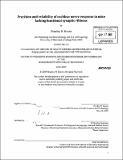| dc.contributor.advisor | M. Charles Liberman. | en_US |
| dc.contributor.author | Buran, Bradley N. (Bradley Nicholas) | en_US |
| dc.contributor.other | Harvard University--MIT Division of Health Sciences and Technology. | en_US |
| dc.date.accessioned | 2010-04-28T15:35:00Z | |
| dc.date.available | 2010-04-28T15:35:00Z | |
| dc.date.copyright | 2009 | en_US |
| dc.date.issued | 2009 | en_US |
| dc.identifier.uri | http://hdl.handle.net/1721.1/54454 | |
| dc.description | Thesis (Ph. D.)--Harvard-MIT Division of Health Sciences and Technology, 2009. | en_US |
| dc.description | Cataloged from PDF version of thesis. | en_US |
| dc.description | Includes bibliographical references (p. 87-99). | en_US |
| dc.description.abstract | Synaptic ribbons are electron-dense structures surrounded by vesicles and anchored to the presynaptic membrane of photoreceptors, retinal bipolar cells and hair cells. Ribbon synapses are characterized by sustained exocytosis that is graded with stimulus intensity and can achieve high release rates. Leading hypotheses implicate the ribbon in maintenance of a large readily releasable pool (RRP) of presynaptic vesicles which enables rapid and precisely-timed exocytosis that supports instantaneous discharge rates of well over 1000 spikes per second. To gain insight into the function of this specialized presynaptic molecular machinery, we characterized the response properties of single auditory nerve (AN) fibers in a mouse with targeted deletion of a presynaptic scaffolding gene, bassoon, in which ribbons are no longer anchored to the active zone. Since each mammalian AN fiber usually receives input from a single inner hair cell active zone to which a single ribbon is typically anchored, single-fiber recordings from bassoon mutants and control mice offer a sensitive functional metric of the contribution of individual ribbons to neural function. Response properties of mutant AN fibers were similar, in many respects, to wild-type. Spike intervals remained irregular, thresholds were unaffected, dynamic range was unchanged, spike synchronization to | en_US |
| dc.description.abstract | (cont.) stimulus phase was unimpaired, the time course of post-onset adaptation and recovery from adaptation were normal, and the ability to sustain discharge throughout a long-duration stimulus was unaffected. These data indicate that the presynaptic mechanisms which regulate precise timing of exocytosis, graded release rates and sustained neurotransmitter release were not impaired by loss of the ribbon. However, reductions were seen in spontaneous and sound-evoked AN fiber discharge rates, coinciding with an increased variance of first spike timing to stimulus onset. Unlike fibers from wild-type mice, mutants failed to show increased peak rate as stimulus onset became more abrupt. The reduction of peak rates and increased first spike variance likely result from degraded reliability of discharge to stimulus onset via a mechanism such as reduced RRP size. Thus, the ribbon appears to support a large RRP that enables the rapid onset rates necessary for the auditory system to resolve stimulus features key for many perceptual tasks. | en_US |
| dc.description.statementofresponsibility | by Bradley N. Buran. | en_US |
| dc.format.extent | 99 p. | en_US |
| dc.language.iso | eng | en_US |
| dc.publisher | Massachusetts Institute of Technology | en_US |
| dc.rights | M.I.T. theses are protected by
copyright. They may be viewed from this source for any purpose, but
reproduction or distribution in any format is prohibited without written
permission. See provided URL for inquiries about permission. | en_US |
| dc.rights.uri | http://dspace.mit.edu/handle/1721.1/7582 | en_US |
| dc.subject | Harvard University--MIT Division of Health Sciences and Technology. | en_US |
| dc.title | Precision and reliability of cochlear nerve response in mice lacking functional synaptic ribbons | en_US |
| dc.type | Thesis | en_US |
| dc.description.degree | Ph.D. | en_US |
| dc.contributor.department | Harvard University--MIT Division of Health Sciences and Technology | |
| dc.identifier.oclc | 551154006 | en_US |
